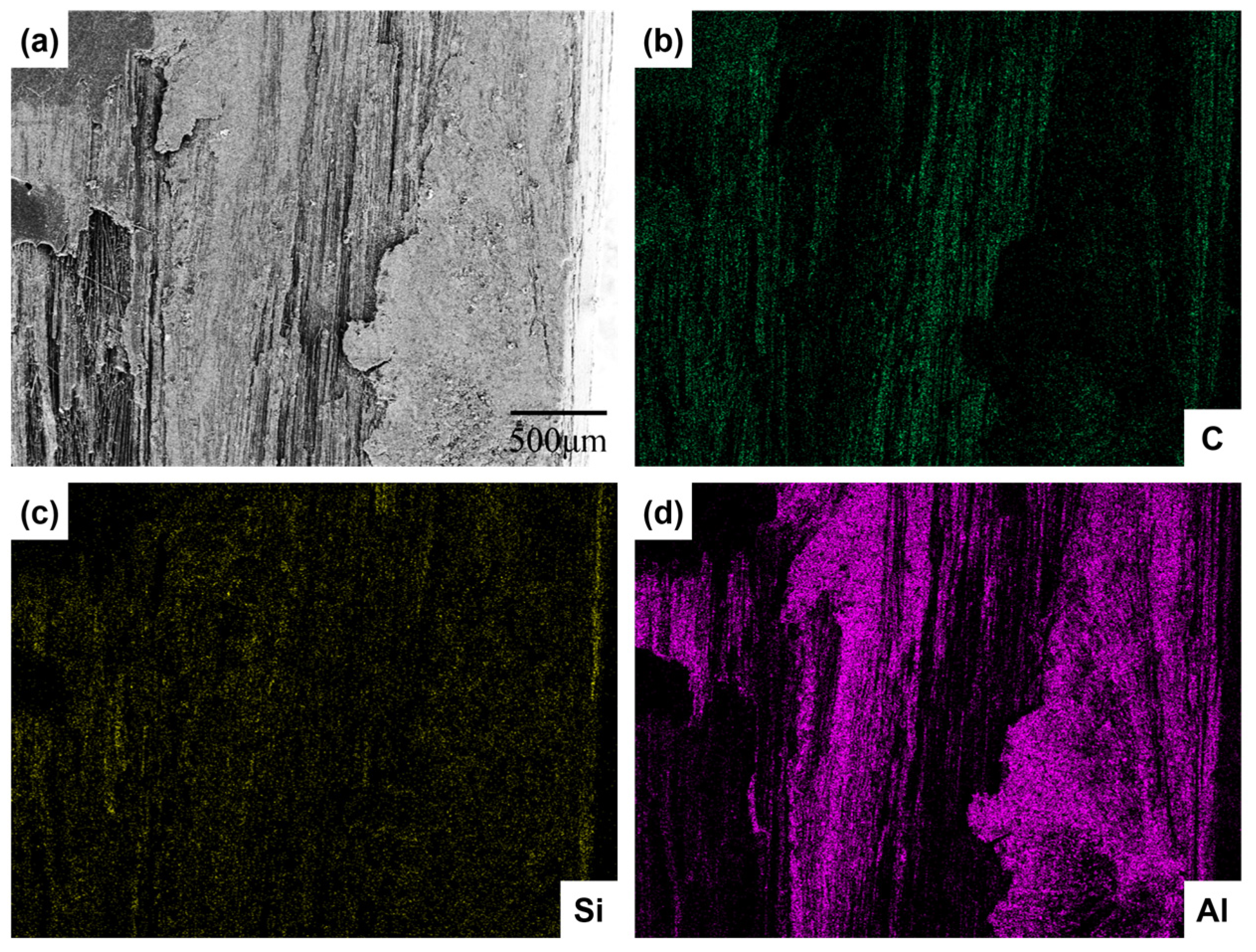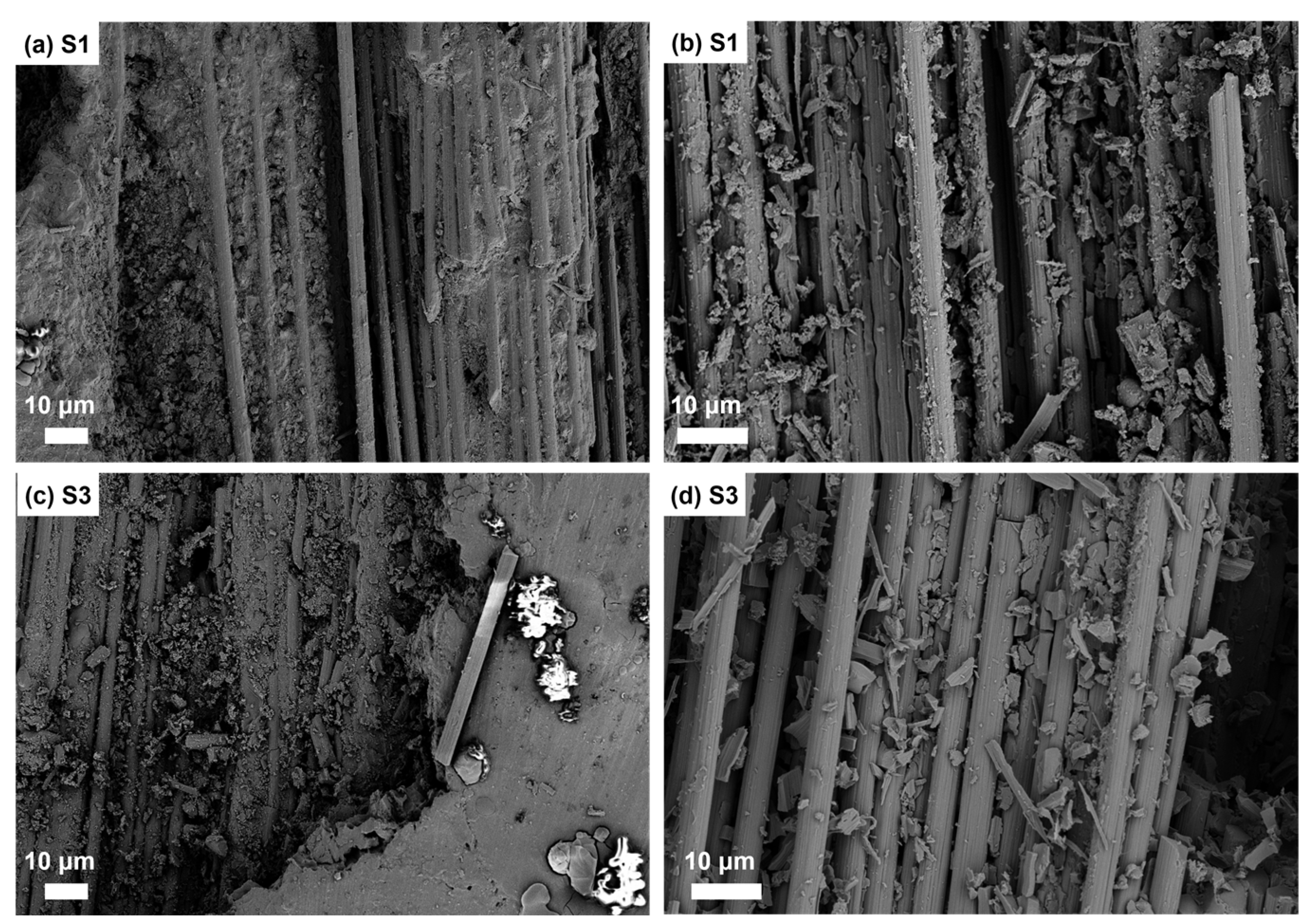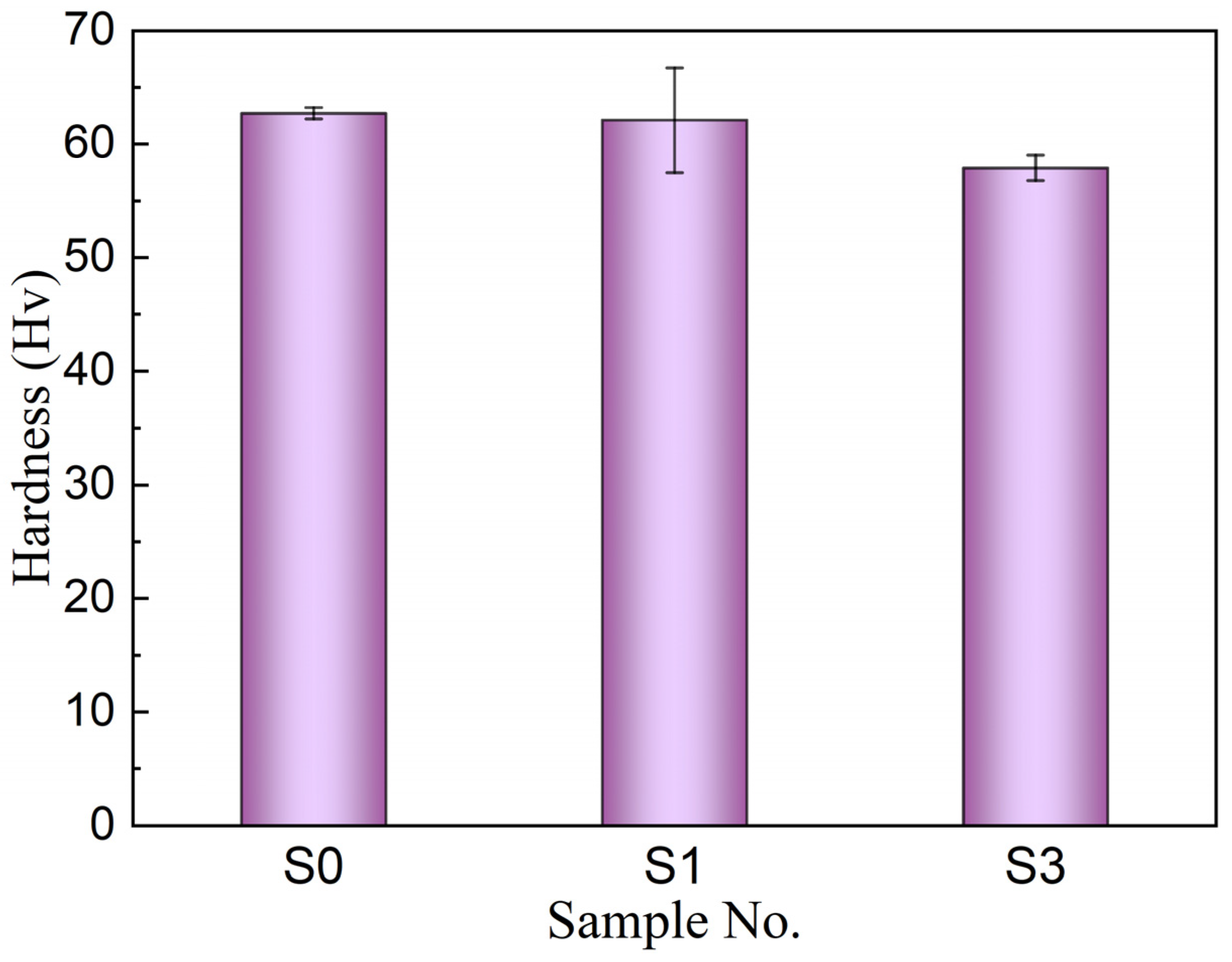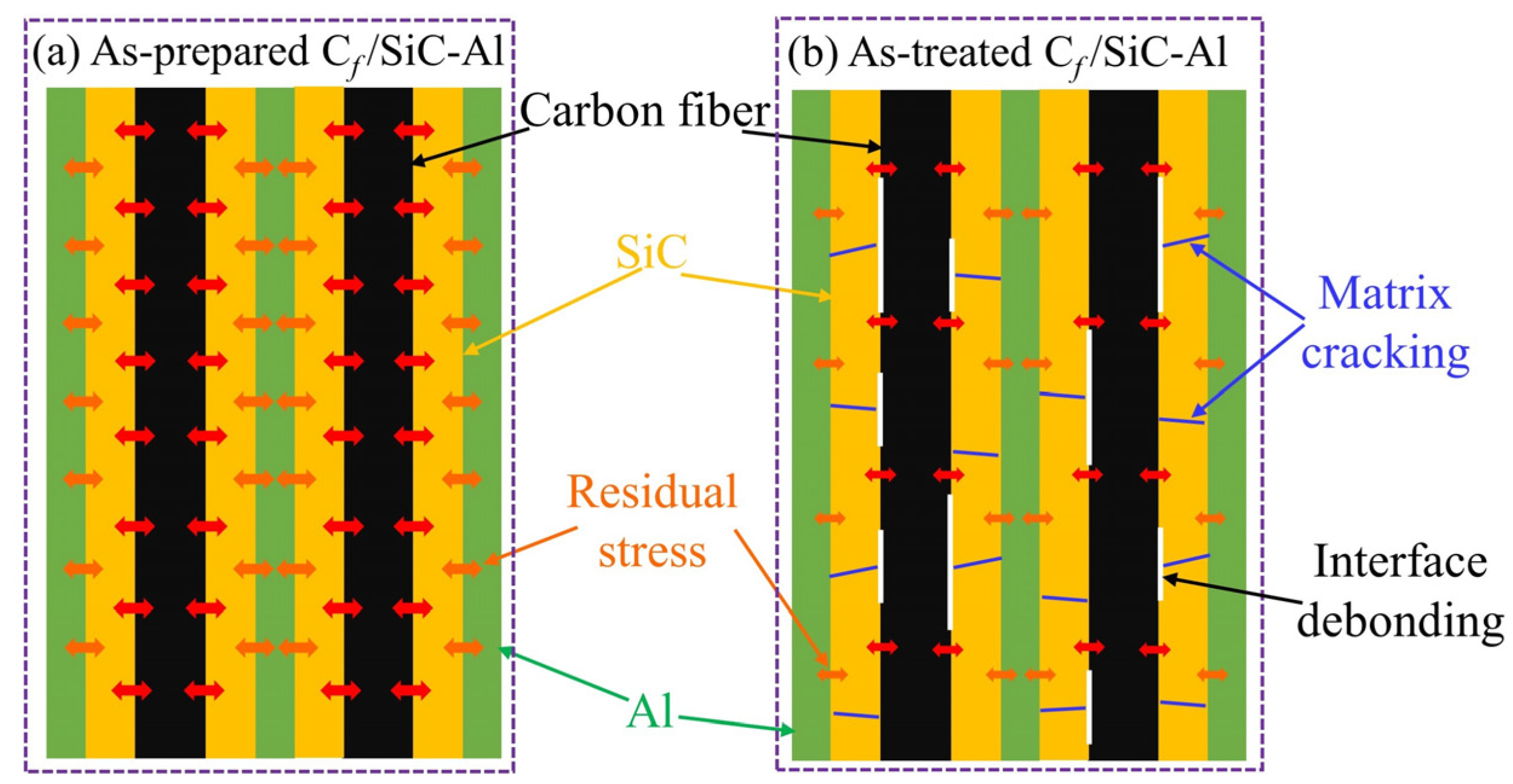Temperature Resistance Properties of Unidirectional Laminated Cf/SiC-Al Prepared by PIP and Vacuum Pressure Infiltration
Abstract
:1. Introduction
2. Experimental Procedure
3. Results and Discussion
3.1. Mechanical Properties
3.2. Microstructure Analysis of Cf/SiC-Al
3.3. Hardness Comparison before and after Heat-Treatment
3.4. Mechanism Comparison before and after Heat-Treatment
4. Conclusions
Supplementary Materials
Author Contributions
Funding
Institutional Review Board Statement
Informed Consent Statement
Data Availability Statement
Acknowledgments
Conflicts of Interest
References
- Wang, Y.Q.; Zhang, L.T.; Cheng, L.F.; Mei, H.; Ma, J.Q. Characterization of tensile behavior of a two-dimensional woven carbon/silicon carbide composite fabricated by chemical vapor infiltration. Mat. Sci. Eng. A 2008, 497, 295–300. [Google Scholar] [CrossRef]
- Fan, X.M.; Ma, X.K.; Dang, X.L.; Xue, J.M.; Ye, F.; Zhao, D.L.; Cheng, L.F. In-plane thermal expansion behavior of dense ceramic matrix composites containing SiBC matrix. J. Eur. Ceram. Soc. 2020, 40, 3414–3422. [Google Scholar] [CrossRef]
- Qi, L.H.; Zhou, Y.Q.; Zhou, J.M.; Hou, X.H.; Li, H.J. Effect of fiber orientation on mechanical properties of 2D-C-f/Al composites by liquid-solid extrusion following Vacuum infiltration technique. Mat. Sci. Eng. A-Struct. 2015, 625, 343–349. [Google Scholar] [CrossRef]
- Li, D.G.; Chen, G.Q.; Jiang, L.T.; Xiu, Z.Y.; Zhang, Y.H.; Wu, G.H. Effect of thermal cycling on the mechanical properties of Cf/Al composites. Mat. Sci. Eng. A-Struct. 2013, 586, 330–337. [Google Scholar] [CrossRef]
- Xiang, Y.; Li, W.; Wang, S.; Chen, Z.H. Effects of the single layer CVD SiC interphases on the mechanical properties of the C/SiC composites fabricated by PIP process. Mat. Sci. Eng. A-Struct. 2012, 558, 451–455. [Google Scholar]
- Callaway, E.B.; Zok, F.W. Tensile response of unidirectional ceramic minicomposites. J. Mech. Phys. Solids 2020, 138, 103903. [Google Scholar] [CrossRef]
- Li, Y.C.; Liu, X.; Chen, G.; Ren, C.Z. Study on interfacial debonding stress and damage mechanisms of C/SiC composites using acoustic emission. Ceram. Int. 2021, 47, 4512–4520. [Google Scholar] [CrossRef]
- Liu, Y.F.; Li, L.B.; Zhang, Z.W.; Xiong, X. Monotonic and Cyclic Loading/Unloading Tensile Behavior of 3D Needle-Punched C/SiC Ceramic-Matrix Composites. Materials 2021, 14, 57. [Google Scholar] [CrossRef]
- Mei, H.; Bai, Q.L.; Sun, Y.Y.; Li, H.Q.; Wang, H.Q.; Cheng, L.F. The effect of heat treatment on the strength and toughness of carbon fiber/silicon carbide composites with different pyrolytic carbon interphase thicknesses. Carbon 2013, 57, 288–298. [Google Scholar] [CrossRef]
- Mei, H.; Lu, M.Y.; Zhou, S.X.; Cheng, L.F. The effect of heat treatment on tensile properties of 2D C/SiC composites. Int. J. Appl. Ceram. Technol. 2021, 18, 162–169. [Google Scholar] [CrossRef]
- Mei, H.; Li, H.Q.; Bai, Q.L.; Zhang, Q.; Cheng, L.F. Increasing the strength and toughness of a carbon fiber/silicon carbide composite by heat treatment. Carbon 2013, 54, 42–47. [Google Scholar] [CrossRef]
- Udayakumar, A.; Ganesh, A.S.; Raja, S.; Balasubramanian, M. Effect of intermediate heat treatment on mechanical properties of SiCf/SiC composites with BN interphase prepared by ICVI. J. Eur. Ceram. Soc. 2011, 31, 1145–1153. [Google Scholar] [CrossRef]
- Ma, X.K.; Yin, X.W.; Cao, X.Y.; Chen, L.Q.; Cheng, L.F.; Zhang, L.T. Effect of heat treatment on the mechanical properties of SiCf/BN/SiC fabricated by CVI. Ceram. Int. 2016, 42, 3652–3658. [Google Scholar] [CrossRef]
- Cheng, T.B.; Zhang, R.B.; Pei, Y.M.; Ai, S.G.; He, R.J.; Zhao, Y.N.; Fang, D.N.; Yang, Y.Z. Tensile properties of two-dimensional carbon fiber reinforced silicon carbide composites at temperatures up to 1800 °C in air. Extreme Mech. Lett. 2019, 31, 100546. [Google Scholar] [CrossRef]
- Cheng, T.B.; Wang, X.R.; Zhang, R.B.; Pei, Y.M.; Ai, S.G.; He, R.J.; Fang, D.N.; Yang, Y.Z. Tensile properties of two-dimensional carbon fiber reinforced silicon carbide composites at temperatures up to 2300 °C. J. Eur. Ceram. Soc. 2020, 40, 630–635. [Google Scholar] [CrossRef]
- Yang, C.P.; Zhang, L.; Wang, B.; Huang, T.; Jiao, G.Q. Tensile behavior of 2D-C/SiC composites at elevated temperatures: Experiment and modeling. J. Eur. Ceram. Soc. 2017, 37, 1281–1290. [Google Scholar] [CrossRef]
- Cheng, T.B. Ultra-high-temperature mechanical behaviors of two-dimensional carbon fiber reinforced silicon carbide composites: Experiment and modeling. J. Eur. Ceram. Soc. 2021, 41, 2335–2346. [Google Scholar] [CrossRef]
- Li, D.S.; Luo, G.; Yao, Q.Q.; Jiang, N.; Jiang, L. High temperature compression properties and failure mechanism of 3D needle-punched carbon/carbon composites. Mat. Sci. Eng. A 2015, 621, 105–110. [Google Scholar] [CrossRef]
- Liao, J.H.; Chen, Z.F.; Guan, T.R.; Li, Y.H.; Xiao, Q.Q.; Xue, L.P. High compression performance of Cf/SiC-Al composites fabricated by CVI and vacuum pressure infiltration. Mat. Sci. Eng. A 2021, 811, 141051. [Google Scholar] [CrossRef]
- Xue, L.P.; Chen, Z.F.; Liao, J.H.; Xiao, Q.Q.; Li, Y.H. Compressive strength and damage mechanisms of 3D needle-punched Cf/SiC-Al composites. J. Alloys Compd. 2021, 853, 156934. [Google Scholar] [CrossRef]
- Sha, J.J.; Lv, Z.Z.; Lin, G.Z.; Dai, J.X.; Zu, Y.F.; Xian, Y.Q.; Zhang, W.; Cui, D.; Yan, C.L. Synergistic strengthening of aluminum matrix composites reinforced by SiC nanoparticles and carbon fibers. Mater. Lett. 2020, 262, 127024. [Google Scholar] [CrossRef]
- Alten, A. Production and mechanical characterization of Ni-coated carbon fibers reinforced Al-6063 alloy matrix composites. J. Alloys Compd. 2019, 787, 543–550. [Google Scholar] [CrossRef]
- Yi, L.F.; Yamamoto, T.; Onda, T.; Chen, Z.C. Microstructure and thermal properties of nickel-coated carbon fibers/aluminum composites. J. Compos. Mater. 2020, 54, 2539–2548. [Google Scholar] [CrossRef]
- Wang, Z.J.; Wang, Z.Y.; Xiong, B.W.; Cai, C.C.; Xu, Z.F.; Yu, H. Micromechanics analysis on the microscopic damage mechanism and mechanical behavior of graphite fiber-reinforced aluminum composites under transverse tension loading. J. Alloys Compd. 2020, 815, 152459. [Google Scholar] [CrossRef]
- Zhu, C.N.; Su, Y.S.; Zhang, D.; Ouyang, Q.B. Effect of Al2O3 coating thickness on microstructural characterization and mechanical properties of continuous carbon fiber reinforced aluminum matrix composites. Mat. Sci. Eng. A 2020, 793, 139839. [Google Scholar] [CrossRef]
- Zhang, J.J.; Liu, J.M.; Liu, Y.P.; Liu, Y.; Li, T.J. Infiltration behavior and mechanism in semi-solid rolling of carbon fibers reinforced Al-matrix composite. Mater. Des. 2019, 182, 108102. [Google Scholar] [CrossRef]
- Li, Y.H.; Chen, Z.F.; Liao, J.H.; Guan, T.R.; Xue, L.P.; Xiao, Q.Q. Failure mechanism and tensile constitutive model of the unidirectional-laminated C-f/SiC-Al composites. Ceram. Int. 2021, 47, 24527–24533. [Google Scholar] [CrossRef]
- Gowayed, Y.; Ojard, G.; Santhosh, U.; Jefferson, G. Modeling of crack density in ceramic matrix composites. J. Compos. Mater. 2015, 49, 2285–2294. [Google Scholar] [CrossRef]
- Mei, H. Measurement and calculation of thermal residual stress in fiber reinforced ceramic matrix composites. Compos. Sci. Technol. 2008, 68, 3285–3292. [Google Scholar] [CrossRef]






Disclaimer/Publisher’s Note: The statements, opinions and data contained in all publications are solely those of the individual author(s) and contributor(s) and not of MDPI and/or the editor(s). MDPI and/or the editor(s) disclaim responsibility for any injury to people or property resulting from any ideas, methods, instructions or products referred to in the content. |
© 2023 by the authors. Licensee MDPI, Basel, Switzerland. This article is an open access article distributed under the terms and conditions of the Creative Commons Attribution (CC BY) license (https://creativecommons.org/licenses/by/4.0/).
Share and Cite
Guan, T.; Lu, L.; Chen, Z.; Yang, L. Temperature Resistance Properties of Unidirectional Laminated Cf/SiC-Al Prepared by PIP and Vacuum Pressure Infiltration. Materials 2023, 16, 5445. https://doi.org/10.3390/ma16155445
Guan T, Lu L, Chen Z, Yang L. Temperature Resistance Properties of Unidirectional Laminated Cf/SiC-Al Prepared by PIP and Vacuum Pressure Infiltration. Materials. 2023; 16(15):5445. https://doi.org/10.3390/ma16155445
Chicago/Turabian StyleGuan, Tianru, Le Lu, Zhaofeng Chen, and Lixia Yang. 2023. "Temperature Resistance Properties of Unidirectional Laminated Cf/SiC-Al Prepared by PIP and Vacuum Pressure Infiltration" Materials 16, no. 15: 5445. https://doi.org/10.3390/ma16155445



